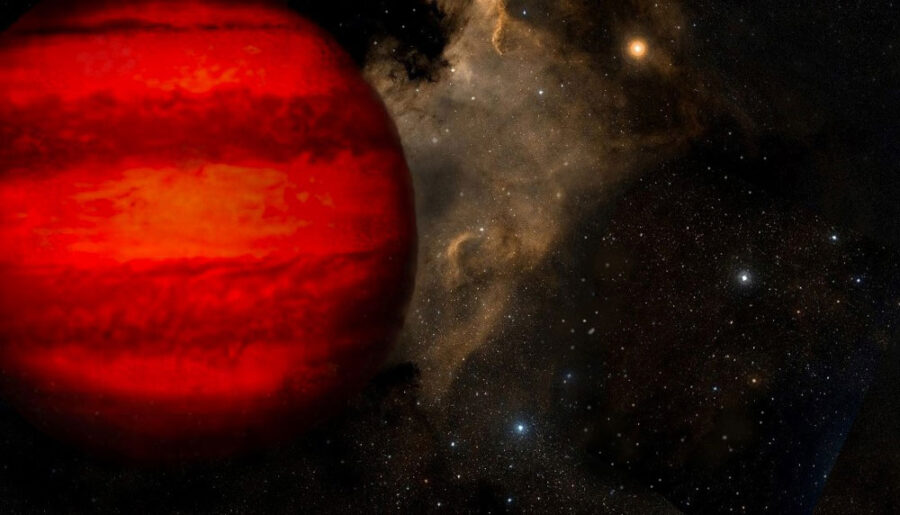Astronomers and citizen scientists have found two would-be stars lacking heavy elements. They’re most likely ancient survivors of our galaxy’s earliest days.
Brown dwarfs live forever. These Jupiter-size balls of gas aren’t massive enough to maintain nuclear fusion in their cores, so they never light up as stars. But they never blow up or collapse the way stars do either. Instead, they radiate the heat leftover from their formation until they’ve faded away.

William Pendrill
This sort-of immortality means that ancient brown dwarfs born in the Milky Way’s infancy are still around and could shed light on how star formation happened back then. Now we just have to find them. A team of astronomers and citizen scientists participating in the Backyard Worlds: Planet 9 project have done just that with the discovery of two odd-looking brown dwarfs. Adam Schneider (Arizona State University) and colleagues will publish the results in the Astrophysical Journal (preprint available here).
In Backyard Worlds, citizen scientists examine data from NASA's Wide-field Infrared Survey Explorer (WISE) mission. The primary goal is to find Planet 9, if it exists. But while they’re looking for objects that are moving across the sky from one frame to another, citizen scientists can also happen upon brown dwarfs. Failed stars are faint, so those that are actually visible tend to be nearby and therefore their motion is more apparent than the more distant stars in the background.
Arttu Sainio independently discovered the first brown dwarf, WISEA 1810–1010, even as professional astronomers had also picked it as a promising target for follow-up observations. Four citizen scientists, Paul Beaulieu, Sam Goodman, William Pendrill, and Austin Rothermich, independently discovered the second object, WISEA 0414–5854. (The citizen scientists are all coauthors of the study, too.)
Additional observations at other wavelengths confirmed these sources were brown dwarfs, but strange ones. “Indeed, the spectra of these objects look pretty weird (to brown dwarf astronomers),” notes study coauthor Adam Burgasser (University of California, San Diego). The best explanation is that these brown dwarfs lack heavy elements. Technically, that marks them as “extreme subdwarfs of the T class,” the authors write. The objects both weigh in at around 75 times Jupiter’s mass and have temperatures around 1200–1400 K.
For the brown dwarfs to have low amounts of heavy elements implies that they are ancient; the researchers estimate that they’re around 10 billion years old. “These objects represent our first unambiguous example of brown dwarfs that are likely part of the ancient halo population of the Milky Way Galaxy,” Burgasser says.
Astronomers still argue about how brown dwarfs form — whether the process is more like stars or like planets. The existence of these two brown dwarfs suggests that whichever the process is, it was just as active in the young Milky Way, which was smaller, messier, and lacking the heavy elements that make star formation more efficient.
Finding more brown dwarfs will help solidify the picture: “There may be many more since any brown dwarfs that formed 10 billion years ago are still around,” Burgasser adds. “Brown dwarfs never die.”
 3
3









Comments
[email protected]
July 24, 2020 at 11:19 pm
I understood that Brown Dwarfs, at least sometimes, are able to fuse Helium even though they are too low mass to fuse hydrogen. This gives Brown Dwarfs at least some time as actual stars.
What is the actual situation/definition?
You must be logged in to post a comment.
Martian-Bachelor
July 30, 2020 at 1:58 pm
> “These objects represent our first unambiguous example of brown
> dwarfs that are likely part of the ancient halo population of the Milky
> Way Galaxy,” Burgasser says.
If this was the case wouldn't it be evident from the kinematics of the stars? (i.e., they'd be "high velocity" stars)
You must be logged in to post a comment.
Sam Goodman
July 31, 2020 at 9:09 am
Good question, the problem with faint low mass objects is getting full kinematics to confirm they are part of the halo. Currently we only know the proper motion components for these brown dwarfs. Getting a radial velocity will be very hard because subdwarfs have pretty featureless spectra. Getting a distance via parallax is also hard and will require time on big telescopes due to the faintness.
The proper motions are consistent with being high-velocity and thus kinematically old, but until we get the full parameters the best argument is they are clearly extremely metal-poor and thus probably very old. The low temperatures also mean they are unambiguously Brown Dwarfs and not just very low-mass stars.
You must be logged in to post a comment.
You must be logged in to post a comment.